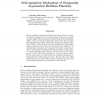Free Online Productivity Tools
i2Speak
i2Symbol
i2OCR
iTex2Img
iWeb2Print
iWeb2Shot
i2Type
iPdf2Split
iPdf2Merge
i2Bopomofo
i2Arabic
i2Style
i2Image
i2PDF
iLatex2Rtf
Sci2ools
NIPS
2001
2001
Self-regulation Mechanism of Temporally Asymmetric Hebbian Plasticity
Recent biological experimental findings have shown that the synaptic plasticity depends on the relative timing of the pre- and postsynaptic spikes which determines whether Long Term Potentiation (LTP) occurs or Long Term Depression (LTD) does. The synaptic plasticity has been called "Temporally Asymmetric Hebbian plasticity (TAH)". Many authors have numerically shown that spatiotemporal patterns can be stored in neural networks. However, the mathematical mechanism for storage of the spatio-temporal patterns is still unknown, especially the effects of LTD. In this paper, we employ a simple neural network model and show that interference of LTP and LTD disappears in a sparse coding scheme. On the other hand, it is known that the covariance learning is indispensable for storing sparse patterns. We also show that TAH qualitatively has the same effect as the covariance learning when spatio-temporal patterns are embedded in the network.
| Added | 31 Oct 2010 |
| Updated | 31 Oct 2010 |
| Type | Conference |
| Year | 2001 |
| Where | NIPS |
| Authors | N. Matsumoto, M. Okada |
Comments (0)

